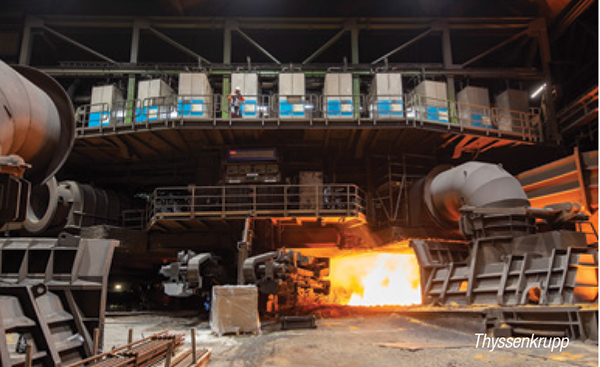Primetals Technologies, Ltd. (London, U.K.; www.primetals.com) and thyssenkrupp AG (Essen, Germany; www.thyssenkrupp.com) have signed an exclusive, worldwide cooperation agreement that sees both parties commit to bringing the Sequence Impulse Process (SIP) technology to the market. The SIP technology has been developed by thyssenkrupp AT.PRO tec GmbH, a company of thyssenkrupp Materials Services GmbH (www.thyssenkrupp-materials-services.com), and is well established for use in foundry cupola furnaces. The underlying principles of this proven technology have been adapted and specifically tailored to the blast-furnace process. To prove the technology, thyssenkrupp Steel Europe has installed the first ever full system on their blast furnace #1 at Schwelgern, Duisburg in Germany (photo).

Blast-furnace operators can conventionally lower operating costs through injection of alternative fuels with the hot-air blast (most commonly pulverized coal) in order to reduce the required coke rate in the burden. Additional O2 enrichment is required to promote combustion for the added fuel. While benefiting the economic aspects for the furnace, this also results in a number of process and operational challenges. Combustion of the fuel localized in the raceway entry leads to higher heat loads on the shell, and uncombusted material (char) can accumulate in the burden. This impedes gas flow and drainage, ultimately reducing the furnace performance efficiency.
The patented SIP technology acts to repurpose the enrichment O 2, and deliver a series of controlled, high-energy pulses, increasing local concentration in the raceway. The resulting action is improved combustion and conversion of fuel, leading to better gas distribution and drainage potential.
Additionally, through higher penetration of the oxygen, the heat load generated is moved more to the central zone of the furnace. The small coke proportion in the burden can be increased without loss of permeability or increased overall pressure drop. These conditions permit an increase in the replacement of coke with injectant and higher production potential while avoiding deterioration of the process conditions.
“By optimizing the consumption of the reducing agents coke and coal, we have a major lever for efficiency improvements, cost and CO 2 savings,” says Jörg Glebe, managing director of thyssenkrupp AT.PRO tec.